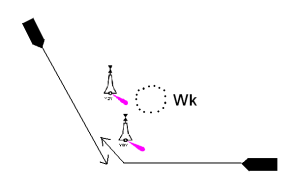The Charity
Aviation
Maritime
Situational Awareness & Seamanship (1)

Initial Report
Report Text:
Illustration only. Not to scale.
0645 Pilot disembarked.
0650 “Vessel B” called on VHF requesting our intention.
I advised him that I would come to stbd. when my vessel was clear of the buoys. He said he would maintain his course and speed. At the time I did not have him plotted on my radar and did not appreciate how close he would pass the buoys.
In the event, he passed only about 1/2 a mile from the buoy, so I ended passing about 2 cables from the “Vessel B” and the buoy.
Afterwards VTS called “Vessel B” advising him that he exercised very poor seamanship; he should have passed the buoy at a greater distance to give my vessel more room.
I would class this as a near-miss.
CHIRP Comment:
This report was forwarded to the operator of Vessel B, who disagreed with the analysis of Vessel A and the VTS; believing Vessel A was most at fault as the give way vessel for not appreciating the risk of collision earlier and acting accordingly.
Looking only at Rule 15, Vessel B is correct, however Rule 2 does state:
(a) Nothing in these Rules shall exonerate any vessel, or the owner, master or crew thereof, from the consequences of any neglect to comply with these rules or of the neglect of any precaution which may be required by the ordinary practice of seamen, or by the special circumstances of the case.
(b) In construing and complying with these Rules due regard shall be had to all dangers of navigation and to any special circumstances, including the limitations of the vessels involved, which may make a departure from these Rules necessary to avoid immediate danger.
The bridge team on Vessel A should have been monitoring the movement of other vessels irrespective of any other activities being undertaken. The VHF communication from Vessel B indicates the bridge team had been monitoring and were aware of the developing situation, but both bridge teams should also have been aware that the planned manoeuvre would occur close to the buoys.
Slowing down could have resolved this situation, but as with many other incidents reported in these pages, it does not appear to have been considered.
The Maritime Advisory Board considered that in this situation it would have been appropriate and seamanlike in these special circumstances for Vessel B to have altered to starboard to allow more room for Vessel A’s intended manoeuvre.
A good bridge team will make an assessment of planned manoeuvres and their impact, and may facilitate application of the Rules or even deviate from accepted practice if the situation warrants it and a proper assessment of the situation has been made.








